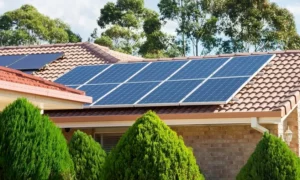Climate change, greenhouse gas emissions, and ozone layer depletion have become global concerns. As a result, people are increasingly aware of their carbon footprint and seeking ways to reduce their impact on the environment. One effective measure is the installation of home solar systems. The sun provides a clean, renewable, and abundant source of energy. Utilizing this energy can empower individuals to take control of their electricity use while minimizing their carbon footprint.
Home solar systems harness sunlight as a primary energy source. These systems convert sunlight into electricity through home solar panels embedded with semiconductor materials. This electricity powers household appliances, equipment, lighting fixtures, and electric vehicles without relying on traditional power sources that produce greenhouse gases such as coal or natural gas-fired power plants.
Solar energy offers numerous benefits besides being environmentally friendly. It minimizes reliance on nonrenewable resources; saves money on utility bills; grants independence from fluctuations in grid-sourced energy pricing; generates local economic growth through job creation; and incentivizes residential renovation investments by increasing property values.
Reduced Carbon Footprint with Solar Energy
Traditional electricity generation relies heavily on fossil fuels such as coal, petroleum, and natural gas – all significant contributors to greenhouse gas emissions. Burning these fuels produces carbon dioxide (CO?), methane (CH4), nitrous oxide (N?O), among other gases that trap heat in the atmosphere leading to global warming.
Solar power generation produces negligible CO? emissions compared to conventional methods since it harnesses a natural source for conversion into usable electricity without burning fossil fuels. By installing solar panels at home or using solar-powered devices frequently, you contribute towards the reduction of CO? released into the atmosphere. Lowering carbon emissions subsequently contributes towards combating climate change, which is essential for safeguarding humanity and ecosystems already reeling from volatile weather patterns and increasing pollution levels.
Evaluating the Effectiveness of Home Solar System Installations
Several factors influence the effectiveness of solar systems in terms of energy production, cost-effectiveness, and eco-friendliness. These include geographic location, orientation and angle of PV panels, panel type and efficiency, system size and output capacity, government incentives, and local electricity prices.
To ensure optimal results from a home solar installation:
- Evaluate your household’s energy requirements to properly scale the system designed to meet your consumption needs
- Ensure optimum positioning of PV panels at calculated inclinations ensuring maximum sunlight exposure year-round
- Consider employing solar tracking technology to further increase solar energy interception throughout the day
- Seek out well-established manufacturers utilizing high-quality materials for longevity and superior energy conversion rates
- Prioritize installing equipment that follows green manufacturing processes free from harmful substances like heavy metals or plastics
- Familiarize yourself with local government policies on renewable energy generation for potential financial incentives and tax rebates that could offset initial installation costs
- Aim for ongoing monitoring of power generation data empowering informed decision-making regarding maintenance requirements
Note: Always consult industry professionals to evaluate site-specific opportunities before deciding on a specific home solar system configuration or device solution.
Maintaining Optimum Performance via Regular Maintenance
Regular inspection is paramount in ensuring optimum performance over time by identifying potential issues requiring correction before impacting overall system efficiency. While many modern solar installations feature low-maintenance hardware solutions, certain areas may require periodic attention to maintain streamlined operation. Basic maintenance steps to keep in mind include:
- Regular cleaning of PV panels for debris or dirt that obstructs sunlight penetration
- Inspection of mounting hardware to identify any signs of wear, degradation or rust
- Checking connections and wiring for integrity or loose terminations impacting proper current flow
- Assessing the inverter and other electrical components for signs of damage or decline in efficiency
- Taking into consideration updates in renewable energy regulations to remunerate households that sell excess solar-generated power back onto the grid
- Monitoring system output via online tools for trends indicative of technical disturbances
Conclusion: Embracing Your Solar-Powered Future
Harnessing the power of the sun through home solar system installations offers a meaningful way to minimize your carbon footprint while enjoying a myriad of practical and economic advantages. Contributions towards curbing global greenhouse gas emissions preserve ecosystems and quality of life both now and into future generations. By diligently evaluating potential solutions, maintaining equipment performance, adapting as regulations evolve, and sharing your commitment to renewable energy solutions with others, we can stand together on solid ground against earth’s environmental challenges.

































